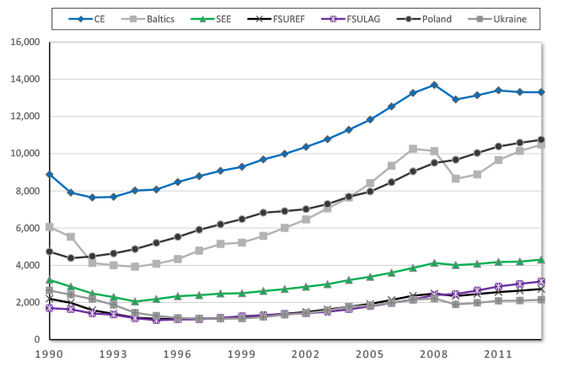Earlier this week, I published, together with two co-authors that included the former deputy minister of finance of Ukraine Oleh Havrylyshyn, a paper on economic reforms in ex-communist countries since the fall of the Berlin Wall. As we explain, the transition from socialism to capitalism divided those who advocated in favor rapid economic reforms from those who advocated in favor of a more gradual approach.
Empirical evidence derived from 25 years of reforms, and their economic and political outcomes, enabled us to test the validity of those two approaches. As we show, early, rapid and extensive reformers by far outperformed gradual reformers on economic measures, such as GDP per capita, on social measures, such as the United Nations Human Development Index, and on institutional measures, such as democracy and the rule of law.
After the fall of the Berlin Wall, a key argument in favor of a gradual approach to reforms was that rapid reforms would cause a great deal of social pain. In reality, rapid reformers experienced shorter recessions and recovered much earlier than gradual reformers. As Figure 1 shows, GDP per capita growth among rapid reformers, such as Central Europe and Baltic states, was much faster than among countries that opted for gradual reform. The latter group of countries included most non-Baltic countries of the former Soviet Union.
Rapid reformers also received much more foreign direct investment, which has stimulated their growth and employment. Importantly, as I will explain below, rapid reformers also ended up with lower rates of income inequality and lower poverty rates. Indeed, the UN HDI, which is a much broader measure of human well-being, points to the same conclusion: the social costs of transition in rapidly reforming countries were lower than those in other ex-communist states.
Figure 1: GDP per Capita by Country Group, 1990–2013 (in 2011 U.S. Dollars Adjusted for Purchasing Power Parity)

(Note: CE = Central European; SEE = Southeast European; FSUREF = Former Soviet Union, gradual reforms; FSULAG = Former Soviet Union, lagged reforms.)
Moreover, the advocates of gradualism argued that institutional reform, such as the development of the rule of law, should precede market liberalization. A stronger legal system, they argued, would increase the effectiveness of economic reforms.
In a strict sense, it is impossible to disprove this argument, for no post-communist country followed that sequence of events. In all ex-communist countries, institutional development lagged considerably behind economic reforms. Waiting for institutional development before implementing economic reforms, therefore, could easily have become a prescription for no reforms at all.
However, after 25 years, rapid reformers ended up with better institutions than gradual reformers. In fact, the fastest progress on institutions was made by the very same countries that undertook rapid economic liberalization (see Figure 2). This outcome is consistent with the hypothesis that political elites who were committed to economic liberalization were also committed to subsequent institutional development.
Conversely, political elites, who advocated gradual reforms, often did so in order to extract maximum rents from the economy. One extreme consequence of gradualism was the formation of oligarchic classes. Rich capitalists have, of course, arisen in all transition economies, but their concentration and degree of political influence appears to be far higher in slowly reforming countries, in particular the large economies of the former USSR.
Figure 2: World Bank’s Rule of Law Indicator by Country Group, 1996–2010

Moreover, trends that were established shortly after the fall of the Berlin Wall held strongly over the past 25 years. Early reform leaders still lead, and most of the laggards still lag. Breaking out of the gradualist mold is not easy, although that was precisely what some people tried to accomplish through the various “color revolutions.” A number of these revolutions initially succeeded – at least to the extent that they overthrew the existing governments in Serbia (2000), Georgia (2003), Ukraine (2004) and the Kyrgyz Republic (2005).
However, only in Georgia did the color revolution lead to real changes in the economic direction of the country. In Ukraine, the most recent example of a successful color revolution, economic and political reforms remain precarious at best.
While the transition is largely over in the most advanced ex-communist countries, legal and regulatory reforms remain unfinished. The lessons from the most advanced countries are not complicated. Countries need to ensure financial stability, and to continue to deregulate and simplify their regulations in order to eliminate corruption and rent-seeking.


